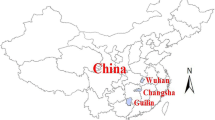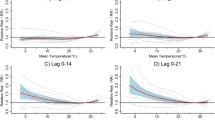Abstract
Ambient air temperature is a key factor affecting human health. Adverse effects of extreme weather on mortality have been well explored and expounded in numerous epidemiological studies. The relationship between moderate temperature and mortality is, however, underexplored. This study quantitatively investigated the temperature-dependent mortality burden in China. Data on daily average temperature and mortality in 15 Chinese cities during 2010–2016 were collected for this study. The association between temperature and city-specific mortality was investigated with a quasi-Poisson regression combined with a distributed lag nonlinear model across lag 0–21 days. The results were then included in a multivariate meta-analysis to derive the pooled estimates of the effect of temperature on mortality at the multi-city level. Mortality fractions attributable to cold and heat (i.e., at temperatures below and above the minimum mortality temperature (MMT)) were calculated. Additionally, temperature ranges were further divided into 1 °C intervals of ambient temperature, and the attributable fractions were calculated for each range. The MMT varied from the 71th to 93th percentiles of temperature in the 15 Chinese cities, centering at the 78th percentile at the multi-city level. In total, 12.65% of non-accidental mortality was attributable to non-optimum temperature, of which cold and hot temperatures corresponded to attributable fractions of 11.38% and 1.27%, respectively. The results of temperature stratifications suggested that moderately cold temperatures provided the highest contribution to mortality caused by temperature. Specifically, the highest attributable fractions were at 7 °C, 7 °C, 8 °C, 8 °C, 4 °C, 4 °C, 5 °C, 7 °C, 7 °C, 4 °C, 5 °C, 5 °C, 6 °C, 11 °C, and 12 °C, for Harbin, Changchun, Shenyang, Urumqi, Beijing, Tianjin, Shijiazhuang, Xining, Lanzhou, Nanjing, Shanghai, Hefei, Chengdu, Kunming, and Guangzhou, respectively. Cold temperature was responsible for a higher proportion of deaths than heat. Moderate cold temperature contributed to most of the total health burden. Finally, the cumulative total counts of deaths caused by moderate cold were the largest. Although moderate cold conferred a slightly lower relative risk than extreme cold, it was more common than extreme cold. Taken together, our results show that the effects of moderate cold temperature on health should receive more attention. Furthermore, our findings could help improve the prediction of climate change effects on human health and support the development of response strategies for the changing climate.



Similar content being viewed by others
References
Armstrong B, Bell ML, Leon YG et al (2017) Longer-term impact of high and low temperature on mortality: an international study to clarify length of mortality displacement. Environ Health Perspect 125(10):107009
Atsumi A, Ueda K, Irie F, Sairenchi T, Iimura K, Watanabe H, Iso H, Ota H, Aonuma K (2013) Relationship between cold temperature and cardiovascular mortality, with assessment of effect modification by individual characteristics: Ibaraki Prefectural Health Study. Circ J 77(7):1854–1861
Basagaña X, Sartini C, Barreragómez J et al (2011) Heat waves and cause-specific mortality at all ages. Epidemiology. 22(6):765–772
Bhaskaran K, Gasparrini A, Hajat S, Smeeth L, Armstrong B (2013) Time series regression studies in environmental epidemiology. Int J Epidemiol 42(4):1187–1195
Bobb JF, Peng RD, Bell ML, Dominici F (2014) Heat-related mortality and adaptation to heat in the United States. Environ Health Perspect 122(8):811–816
Brooke G, Anderson et al 2009 Weather-related mortality: how heat, cold, and heat waves affect mortality in the United States. Epidemiology (Cambridge, Mass.), 20(2): 205–213
Bunker A, Wildenhain J, Vandenbergh A, Henschke N, Rocklöv J, Hajat S, Sauerborn R (2016) Effects of air temperature on climate-sensitive mortality and morbidity outcomes in the elderly; a systematic review and meta-analysis of epidemiological evidence. Ebiomedicine. 6:258–268
Chen R, Yin P, Wang L et al (2018) Association between ambient temperature and mortality risk and burden: time series study in 272 main Chinese cities. BMJ. 363:k4306
Cuspidi C, Ochoa et al (2010) Seasonal variations in blood pressure: a complex phenomenon. Am J Geriatr Cardiol 13(5):267–272
f R, Ostro BD (2008) A multicounty analysis identifying the populations vulnerable to mortality associated with high ambient temperature in California. Am J Epidemiol 168(6):632–637
Gasparrini A, Armstrong B (2013) Reducing and meta-analyzing estimates from distributed lag non-linear models. BMC Med Res Methodol 13(1):1–1
Gasparrini A, Leone M (2014) Attributable risk from distributed lag models. BMC Med Res Methodol 14(1):55
Gasparrini A, Armstrong B, Kenward MG (2011) Distributed lag nonlinear models. Stat Med 29(21):2224–2234
Gasparrini A, Armstrong B, Kenward MG (2012) Multivariate meta-analysis for non-linear and other multi-parameter associations. Stat Med 31(29):3821–3839
Gasparrini A, Guo Y, Hashizume M, Kinney PL, Petkova EP, Lavigne E, Zanobetti A, Schwartz JD, Tobias A, Leone M, Tong S, Honda Y, Kim H, Armstrong BG (2015) Temporal variation in heat-mortality associations: a multi-country study. Environ Health Perspect 123(11):1200–1207
Guo Y, Gasparrini A, Armstrong B, Li S, Tawatsupa B, Tobias A, Lavigne E, de Sousa Zanotti Stagliorio Coelho M, Leone M, Pan X, Tong S, Tian L, Kim H, Hashizume M, Honda Y, Guo YLL, Wu CF, Punnasiri K, Yi SM, Michelozzi P, Saldiva PHN, Williams G (2014) Global variation in the effects of ambient temperature on mortality: a systematic evaluation. Epidemiology. 25(6):781–789
Guo Y, Gasparrini A, Armstrong B et al (2016) Temperature variability and mortality: a multi-country study. Environ Health Perspect 124(10):1554–1559
Heo S, Lee E, Bo YK et al (2016) Long-term changes in the heat-mortality relationship according to heterogeneous regional climate: a time-series study in South Korea. BMJ Open 6(8):e011786
Higgins JP, Thompson SG (2002) Quantifying heterogeneity in a meta-analysis. Stat Med 21(11):1539–1558
Huang C, Barnett AG, Wang X, Tong S (2012) Effects of extreme temperatures on years of life lost for cardiovascular deaths: a time series study in Brisbane, Australia. Circ Cardiovasc Qual Outcomes 5(5):609–614
Huynen MM, Martens P, Schram D, Weijenberg MP, Kunst AE (2001) The impact of heat waves and cold spells on mortality rates in the Dutch population. Environ Health Perspect 109(5):463–470
IPCC 2007 Climate Change 2007: impacts, adaptation and vulnerability. Contribution of Working Group II to the Fourth Assessment Report of the Intergovernmental Panel on Climate Change. Cambridge University Press, Cambridge, UK
Keatinge WR, Coleshaw SR, Easton JC et al (1986) Increased platelet and red cell counts, blood viscosity, and plasma cholesterol levels during heat stress, and mortality from coronary and cerebral thrombosis. Am J Med 81(5):795–800
Pagan E, Chatenoud L, Rodriguez T et al (2016) Comparison of trends in mortality from coronary heart and cerebrovascular diseases in north and South America: 1980 to 2013. Am J Cardiol 119(6):862
Rachel L, Joan B, James C et al (2015) Evaluating the performance of a climate-driven mortality model during heat waves and cold spells in Europe. Int J Environ Res Public Health 12(2):1279–1294
Scovronick N, Sera F, Acquaotta F, Garzena D, Fratianni S, Wright CY, Gasparrini A (2018) The association between ambient temperature and mortality in South Africa: a time-series analysis. Environ Res 161:229–235
Tobías A, Armstrong B, Gasparrini A (2017) Investigating uncertainty in the minimum mortality temperature: methods and application to 52 Spanish cities. Epidemiology. 28(1):72–76
Vicedo-Cabrera AM, Sera F, Guo Y et al (2017) A multi-country analysis on potential adaptive mechanisms to cold and heat in a changing climate. Environ Int 111:239
Woodhouse PR, Khaw KT, Plummer M, Meade TW, Foley A (1994) Seasonal variations of plasma fibrinogen and factor vii activity in the elderly: winter infections and death from cardiovascular disease. Lancet. 343(8895):435–439
Yang J, Yin P, Zhou M, Ou CQ, Guo Y, Gasparrini A, Liu Y, Yue Y, Gu S, Sang S, Luan G, Sun Q, Liu Q (2015) Cardiovascular mortality risk attributable to ambient temperature in China. Heart 101(24):1966–1972
Zhang Y, Wang S, Fan X et al (2018) Temperature modulation of the health effects of particulate matter in Beijing, China. Environ Sci Pollut Res 25(2):1–10
Zheng S, Wang M, Li B, Wang S, He S, Yin L, Shang K, Li T (2016) Gender, age and season as modifiers of the effects of diurnal temperature range on emergency room admissions for cause-specific cardiovascular disease among the elderly in Beijing. Int J Environ Res Public Health 13(5):447
Zhou MG, Wang LJ, Liu T, Zhang YH, Lin HL, Luo Y, Xiao JP, Zeng WL, Zhang YW, Wang XF, Gu X, Rutherford S, Chu C, Ma WJ (2014) Health impact of the 2008 cold spell on mortality in subtropical China: the climate and health impact national assessment study (CHINAs). Environ Health 13:60
Acknowledgements
We thank Canjun Zhen for providing daily death data of fifteen Chinese cities.
Funding
This study was supported by the National key Research and Development Program of China (2016YFA0602004), the National Natural Science Foundation of China (91644226), Special Project on Major Science and Technology of Sichuan Province (2018SZDZX0023), the Chengdu University of Information Technology scientific research fund (KYTZ201713), and Sichuan Provincial Department of Education scientific research fund (2018Z114).
Author information
Authors and Affiliations
Corresponding author
Ethics declarations
Conflict of interest
The authors declare that they have no competing interests.
Additional information
Responsible editor: Philippe Garrigues
Publisher’s note
Springer Nature remains neutral with regard to jurisdictional claims in published maps and institutional affiliations.
Electronic supplementary material
ESM 1
(DOCX 25 kb)
Rights and permissions
About this article
Cite this article
Zhang, Y., Wang, S., Zhang, X. et al. Association between moderately cold temperature and mortality in China. Environ Sci Pollut Res 27, 26211–26220 (2020). https://doi.org/10.1007/s11356-020-08960-5
Received:
Accepted:
Published:
Issue Date:
DOI: https://doi.org/10.1007/s11356-020-08960-5




